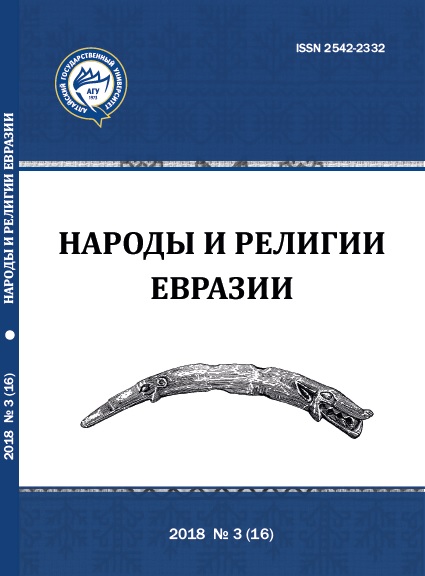Bulgarian golden filigrane pendants with bird figures: to the question of origin
Main Article Content
Abstract
The article is devoted to the study of gold filigree pendants with a miniature figure of a bird from the Volga Bulgaria. There are not many of them. In total, sixteen such artifacts are kept in museums of the Russian Federation and in private collections of pendants with a bird figurine. If we take into account similar filigree pendants, but without the figure of a bird, the total number of them reaches 25 copies. These pendants of the 11th-12th centuries are dated. The author believes that they began to be produced in the second third quarter of the 11th century in one of the jewelry manufactory in Volga Bulgaria.
Analysis of the technology and design of these pendants led the author to the conclusion that most of the constructive elements, including the bird figurine, were borrowed from jewelery from the Middle East, primarily from Iran and Syria. This made it possible to hypothesize that this production in the Volga Bulgaria was organized or headed by a jeweler from the Middle East. With this region is connected and a figure of a bird in a suspension bracket. This is one of the symbols in Iranian art, which was reflected in other Iranian products where a bird was depicted, for example, on ceramic and some metal bowls. The obvious connection between the filigree gold pendants and other similar products of the Bulgarian jewelers was not revealed. The author believes that these pendants are of Bulgarian origin. These pendants are of Bulgarian origin made in the artistic traditions of j ewelry of the Middle East of the 10th-11th centuries.
Downloads
Metrics
Article Details
References
Казаков Е. П. Булгарское село X-XIII веков низовий Камы. Казань : Татар. кн. изд-во, 1991. 176 с.
Казаков Е. П. Культура ранней Волжской Болгарии (этапы этнокультурной истории). М. : Наука, 1992. 335 с.
Классическое искусство исламского мира IX-XIX веков // Девяносто девять имен Всевышнего / сост. Г. Ласикова. М. : Изд. дом Марджани, 2013. 432 с.
Коллекции Михаила и Сергея Боткиных / ред. Н. Мельник. СПб. : Изд-во Государственного русского музея, 2011. 216 с.
Левашова В. П. О сходстве височных украшений волжских болгар с великоморав-скими // Древности Восточной Европы. М. : Наука, 1969. С. 125-130.
Лесман Ю. М., Рябцева C. C. О многобусинных кольцах, европейской моде и этнографическом уборе // Stratum plus. 2013. № 5. С. 309-336.
Поп И. И. Искусство Чехии и Моравии IX — начала XVI века. М. : Искусство, 1978. 255 с. (Очерки истории и теории изобразительного искусства).
Путешествие Ибн Фадлана: Волжский путь от Багдада до Булгара. Каталог выставки. М. : Изд. дом Марджани, 2016. 560 с.
Руденко К. А. Булгарское золото: филигранные височные подвески. Древности Би-ляра. Казань : Заман, 2011. Т. I. 256 с.
Руденко К. А. Булгарское серебро. Древности Биляра. Казань : Заман, 2015. Т. II. 528 с.
Семенова Л. А. Из истории Фатимидского Египта: очерки и материалы. М. : Наука, 1974. 264 с.
Украшения Востока. Из коллекции Патти Кадби Берч, США: каталог. СПб. : ГЭ, 1999. 150 с.
Халиков А. X. Отражение космогонических и генеалогических легенд волжских булгар в археологических материалах // Из истории ранних булгар. Казань, 1981. С. 5-20.
Хлебникова Т. А. Еще одна находка болгарских ювелирных изделий // Советская археология. 1963. № 1. С. 305-309.
Bloom M. J. Arts of the City Victorious: Islamic Art and Architecture in Fatimid North Africa and Egypt. New Haven and London: Yale University Press, 2007. 236 s. (на англ. яз.).
Bosselmann-Ruickbie A. Byzantinischer Schmuck des 9 bis fruhen 13 Jahrhunderts. Wiesbaden: Reichert Verlag, 2011. 420 s. (на нем. яз.).
Court and Cosmos: The Great Age of the Seljuqs. Catalog exhibition held at the Metropolitan Museum of Art, New York, April 27 — July 2016. N.-Y. : The Metropolitan Museum of Art, 2016. 365 s. (на англ. яз.).
Dekan J. Velka Morava. Doba a umenie. Bratislava: Tatran, 1976. 282 s. (на чеш. яз.).
Islam: Art and Architecture / ed. M. Hattstein, P. Delius. Potsdam: Publishing H.f.ullmann, 2013. 624 s. (на англ. яз.).
Jenkins M., Keene M. Islamic jewelry in the Metropolitan museum of Art. N.-Y. : The Metropolitan museum of Art, 1983. 160 s. (на англ. яз.).
Jewelry. 25 000 years of Jewelry from the collections of the Staatliche Museen zu Berlin / ed. M. Eichhorn-Johannsen, A. Rasche. Munich; L.; N-Y. : Prestel, 2013. 384 s. (на англ. яз.).
Spink M., Ogden J. The Art of adornment. Jewellery of the Islamic Lands. Part One. L.: New Foundation, 2013. 372 s. (The Nasser D. Khalili Collection of Islamic Art. Vol. XVII). (на англ. яз.).
Spier J. Byzantium and the West: Jewelry in the First Millenium. Catalog of exhibition. L., 2012. 208 s. (на англ. яз.).
Reab|eva S. Piese de podoaba §i de vestimenta|ie din Moldova §i Tara Romaneasca in contextul rela|iilor cultural-istorice (secolele XIV-XVII). Braila: Editura Istros a Muzeului Brailei, 2014. 386 s. (на молдав. яз.).

